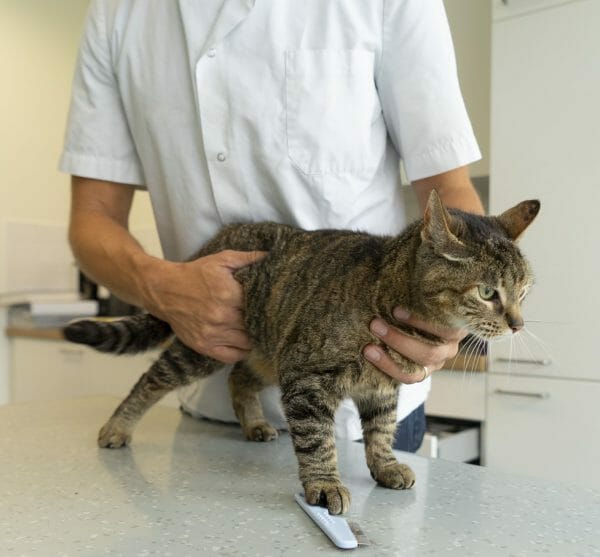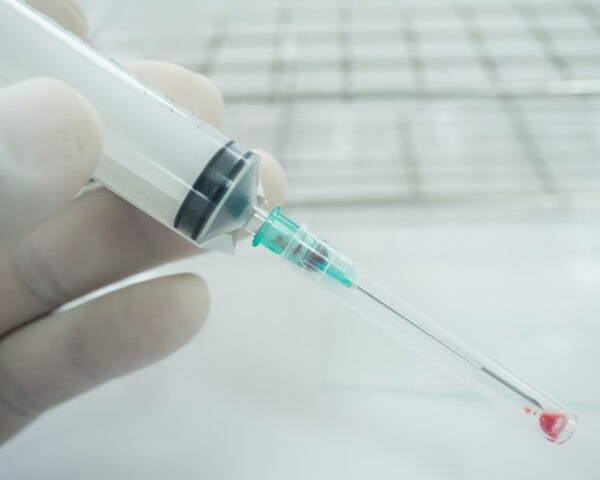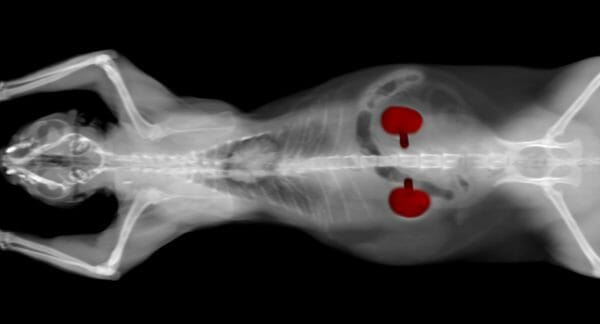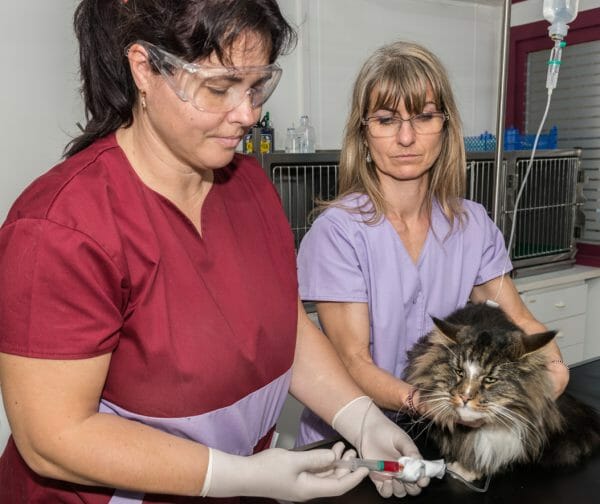Lymphomas in Cats
Lymphoma is cancer of the lymphocytes, which are white blood cells found in the immune system. There are several types of lymphoma in cats, which are classified based on where they manifest in the body. The most common places where cat lymphomas are found include the gastrointestinal tract (intestinal lymphoma), the kidneys (kidney or renal lymphoma), and the chest (mediastinal lymphoma).
Lymphoma in cats can also be classified by the size of the lymphocytes (small cell or large cell). When tissues samples are analyzed, a pathologist can determine whether the lymphoma is high-grade, low-grade, or intermediate-grade. In this context, grade refers to the malignancy of the cells and how quickly the cells are dividing. A high-grade lymphoma is the most malignant.
Because lymphocytes travel throughout the body, lymphoma is a systemic disease rather than a localized disease. This means that surgery and radiography will not always be effective. As a result, chemotherapy is the most common treatment for lymphoma.
Lymphoma is the most frequently seen type of cancer in cats—accounting for approximately 30% of feline cancer cases. Lymphoma in cats is strongly connected to feline leukemia, which is caused by a viral infection. For this reason, unvaccinated outdoor cats are at more risk for the disease than indoor cats. The best way to protect a cat from lymphoma is to vaccinate them for feline leukemia and the feline immunodeficiency virus (FIV).

What Is Intestinal Lymphoma in Cats?
Intestinal lymphoma in cats occurs in a feline’s gastrointestinal tract and is the most common form of lymphoma in felines, accounting for 50% to 70% of lymphomas in cats. Intestinal lymphoma usually takes one of two forms:
- Enteropathy-associated T-cell LSA Type 1 (also called high-grade, large cell, or lymphoblastic lymphoma)
- Enteropathy-associated T-cell LSA Type 2 (also called low-grade, small cell, or indolent lymphoma)
Intestinal lymphoma is most common in older cats. The average age of a feline with intestinal lymphoma is between 9 and 13 years old.
Symptoms of Intestinal Lymphoma in Cats
Signs of intestinal lymphoma in cats include:
- History of chronic weight loss
- Vomiting
- Diarrhea
The feline’s appetite may be varied, meaning they may eat more, less, or about the same.
Diagnosing Intestinal Lymphoma in Cats
Diagnosing intestinal lymphoma in cats usually involves some form of biopsy or needle aspirate. The tissue or cells are then examined under a microscope by a pathologist.
- Surgical biopsy involves opening the feline’s abdomen and removing a piece of tissue for analysis. This type of biopsy allows a vet to see how deeply the malignant cells are penetrating the intestine and allows a pathologist to grade the lymphoma. However, this is an invasive procedure that requires anesthesia and hospitalization.
- Endoscopic biopsy is less invasive than a surgical biopsy and usually results in good quality tissue samples. In this type of biopsy, a long scope is inserted into the feline’s mouth or anus. A small “biter” then removes a small piece of intestinal tissue. The disadvantage of this type of biopsy is that tissue samples are smaller and may not allow for a detailed analysis.
- Needle aspirates remove a sample of cells with a needle, usually using an ultrasound for guidance. Although this is less invasive than a biopsy, a detailed analysis of the affected tissue is not possible. However, this is a less expensive procedure and may be the first diagnostic step.
Additional diagnostic tests that may be used are a complete blood count (CBC), chemistry panel, testing for FeLV/FIV, and urinalysis.

Treatment for Intestinal Lymphoma in Cats
Treating intestinal lymphoma in cats usually involves chemotherapy, which uses powerful chemicals to kill cancer cells. In low-grade intestinal lymphoma, prednisone (a steroid) and chlorambucil (an oral chemotherapy medication) are typically prescribed. In high-grade intestinal lymphoma, injectable chemotherapy drugs are used. Most chemotherapy treatments take approximately 26 weeks.
The good news is that chemotherapy does not affect cats in the same way it affects humans. Cats rarely lose their hair, and most do not become sick. Only 10% of felines experience side effects with chemotherapy, which might include the same symptoms as the cancer (e.g., vomiting, diarrhea, decreased appetite).
Intestinal Lymphoma in Cats Life Expectancy
The prognosis for cats with intestinal lymphoma depends on whether they have Type 1 (high-grade) or Type 2 (low-grade). Low-grade intestinal lymphoma results in remission in approximately 70% of cats who received treatment. Remission means that the cat does not have any signs of the disease; it does not mean the cancer is cured. Typical remission lasts for 2 to 3 years.
The prognosis for high-grade intestinal lymphoma is not as good. Only 25% to 50% of cats achieve remission, which lasts a mere 2 to 9 months.
What Is Kidney Lymphoma in Cats?
Kidney lymphoma in cats (also called renal lymphoma) can lead to kidney failure because cancerous cells begin to replace kidney cells. This process usually results in enlarged kidneys. There is also a strong correlation between kidney lymphoma and feline leukemia. Approximately half of cats with kidney lymphoma also test positive for feline leukemia.
Kidney lymphoma is the worst type of lymphoma in cats. In addition to its correlation with feline leukemia, renal lymphoma also tends to result in tumors in the nervous system, such as in the brain or spinal cord. These tumors appear in 40% of cats with kidney lymphoma.

Symptoms of Kidney Lymphoma in Cats
Signs of kidney lymphoma in cats include:
- Poor appetite
- Excessive water consumption
- Weight loss
- Vomiting
Diagnosing Kidney Lymphoma in Cats
Kidney lymphoma is typically diagnosed by placing a needle directly into the kidney and aspirating the cells. A biopsy is rarely needed unless the cell samples are inconclusive.
Treatment for Kidney Lymphoma in Cats
Kidney lymphoma treatment in cats usually requires chemotherapy. During treatment, the enlarged kidneys become smaller, and kidney function improves. However, these results are often short-lived.
Kidney Lymphoma in Cats Life Expectancy
Unfortunately, cats with renal lymphoma rarely live longer than 3 to 6 months. This is due, in part, to all the complicating factors that come with the condition. However, there are isolated reports of cats that have lived much longer after receiving a diagnosis for kidney lymphoma.

What Is Mediastinal Lymphoma in Cats?
Mediastinal lymphoma in cats occurs in the feline’s mediastinum, which is the connective tissue that contains the heart, esophagus, trachea, lymph nodes, and thymus. With mediastinal lymphoma, the lymph nodes fill up with lymphoma. This fluid takes up space in the chest where the lungs inflate. As a result, it becomes difficult for a feline to breathe.
Most felines with mediastinal lymphoma are younger (less than 5 years old), and almost 80% also test positive for feline leukemia. Siamese cats seem to have a predisposition for this type of lymphoma.
Symptoms of Mediastinal Lymphoma in Cats
Symptoms of mediastinal lymphoma are as follows:
- Shallow rapid breathing
- Open-mouthed breathing
- Persistent cough
- Difficulty eating
Diagnosing Mediastinal Lymphoma in Cats
Diagnosing mediastinal lymphoma typically involves aspirating fluid from the pleural sacs near the lungs and analyzing the cells for lymphoma. A chest x-ray may also reveal the fluid around the lungs.
Treatment for Mediastinal Lymphoma in Cats
As with other forms of lymphoma, chemotherapy is the preferred treatment.
Mediastinal Lymphoma in Cats Life Expectancy
Sadly, the prognosis for cats with mediastinal lymphoma is not good. For felines that are also positive for feline leukemia, the average survival time of 3 months. In cats who do not have feline leukemia, life expectancy is between 9 and 12 months.




